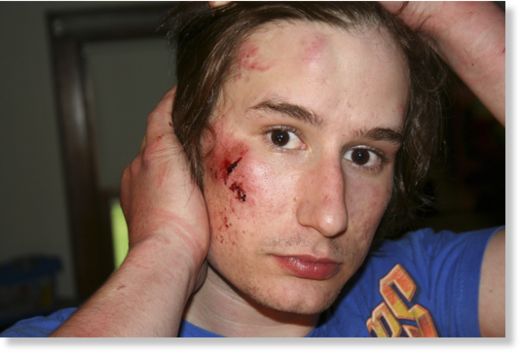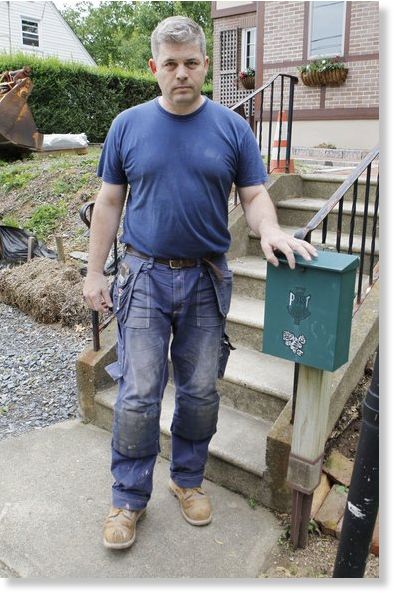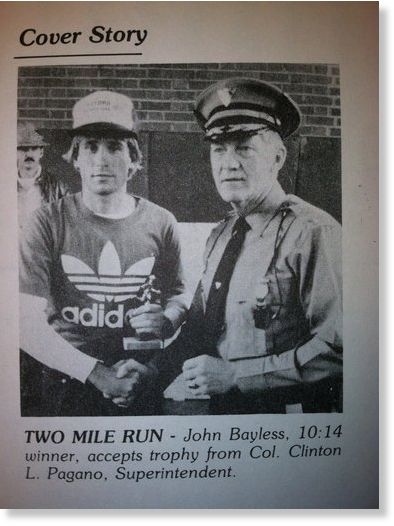On an early May morning in 2009, after the State Police had searched through the night trying to find two burglary suspects in Warren County, they stopped a car James Bayliss, then 21, was riding in and asked him to step outside so he could be searched.
What happened next was captured by a dashboard video camera inside a State Police patrol car. The recording, which never before has been made public, was recently obtained by The Star-Ledger.
It shows Bayliss standing against the car as Staff Sgt. Richard Wambold Jr. frisks him. A few seconds later, after what appears to be a slight movement, the video shows Wambold throw Bayliss to the ground, kneel and punch him several times in the face.
An eyewitness in a nearby home said in a sworn deposition that she watched from her window as two troopers, later identified as Wambold and Trooper Keith Juckett, then dragged a limp, handcuffed Bayliss toward a parked patrol car and rammed his head against a tire.
She said the troopers' actions "disgusted" her.
What's more, Bayliss is not an average young man. A car accident in 2005 left him with a permanent mental disability, and his friend driving the car that morning, Timothy Snyder, told the State Police troopers on the scene about his condition before he was beaten.
On Friday, after being told The Star-Ledger was planning to publish this story and make the video public on nj.com, the State Police announced for the first time that two troopers involved in the incident used unreasonable force.

The announcement came three years and two weeks after the incident, and after nearly two dozen attempts by Bayliss and his family to get an answer.
"Attorney General Jeffrey Chiesa has made it clear that excessive use of force, whether it involves a state trooper or any other law enforcement officer, will not be tolerated and will be met with strong and appropriate disciplinary action," a spokesman for Chiesa, Paul Loriquet, said in a statement. "This case clearly involved a breach of the Attorney General's policy regarding use of force."
Reached at his home Friday, Wambold, a 19-year veteran trooper, declined to comment because of a State Police policy prohibiting troopers from speaking with the media. Juckett, a seven-year trooper, could not be reached for comment.
Told of the development by The Star-Ledger, Bayliss' father, John, was thrilled.
"You don't know how happy I am," he said. "Finally a step toward closure for our family."

Wambold said in his report on the incident in Mansfield Township that Bayliss did several things to provoke a forceful response. While seated in his car, Bayliss repeatedly failed to heed instructions, hid his hands and stared menacingly at troopers, Wambold said.
Wambold said Bayliss tried to head-butt him during the frisk, and once he was on the ground, he struck the trooper with a glancing blow to the lower lip. Wambold also said he smelled alcohol in the car. And Bayliss had been drinking that night, his father and Snyder said.
"Paramount was the possibility of him being an actor or accomplice in the home invasion," Wambold, who works out of Netcong, wrote. He added he was at a "level of heightened caution" because Bayliss matched the description of one of the burglary suspects.
Bayliss' father said Wambold mistook his son's disability for defiance.
"I don't think they realized my son was disabled, even after they were told," John Bayliss said. "I think they were all jacked up and Wambold took it out on him."
Years Later, An Answer
The administrative charges of unreasonable force were substantiated by internal affairs March 23, a spokesman for the State Police, Lt. Stephen Jones, said in a statement. Officials are still determining what disciplinary action will be taken.
Jones said the State Police's investigation began after a supervisor reviewed the incident in 2009, which is customary when a trooper uses force to make an arrest. He said the case underwent a "thorough, in-depth" review by multiple state agencies.
"The Attorney General's Office, the State Police, as well as the Warren County Prosecutor's Office engaged in an exhaustive and systematic process, including reviews to determine if criminal charges were warranted," Jones said. No criminal charges have been filed.
The Attorney General's Office said in its statement that while most troopers perform honorably and with restraint, authorities must "ensure that force is used only as appropriate and authorized to protect the officer and others" and to maintain the public's trust.
The attorney general's guidelines state that a police officer is justified to use physical force as protection, to overcome resistance, to make an arrest and to protect property.
In 2004, Wambold was honored by the State Police with the Distinguished Service Medal for shooting an armed suspect in Warren County a year earlier after the suspect had shot a local police officer.
The Medical Miracle

When he did regain consciousness, he faced a long path to recovery. He had to relearn everything from walking and talking to brushing his teeth and using the bathroom. He is deaf in his right ear, his father said, and walks with a limp.
Minutes before the beating, a trooper's microphone recorded Snyder explaining to troopers that Bayliss' behavior often seemed strange because of the disability. Even though Bayliss had been drinking, Snyder said, "If you see him sober, you would think that he was messed up."
Bayliss was charged with obstructing the administration of law and resisting arrest, but the case was dismissed by a municipal court judge after Wambold failed to show up for the trial. John Bayliss said his son had no prior criminal record.
Last year, Bayliss, now 24, sued in state Superior Court in Warren County, claiming excessive force and wrongful arrest. The case was transferred to U.S. District Court in Newark and is now pending in U.S. District Court in Trenton.
"Obviously the State Police have a difficult job," said Bayliss' attorney, Robert Woodruff. "But they also have an obligation to follow the law and in this instance, as can be seen by looking at the tape, there was no basis whatsoever for taking the action against my client."
Neither Bayliss nor Snyder was involved in the suspected burglary that morning, Woodruff said.
Bayliss, who lives in Hackettstown and works at a hospital cafeteria, declined to comment for this story because of the pending lawsuit. This is the first time details of the suit - including the video, eyewitness account and Wambold's report - have been made public.
Before The Incident
According to Wambold's report, the State Police stopped Bayliss' car that morning after trooper Juckett reported seeing it speeding down Jackson Valley Road near the scene where police were looking for the burglary suspects and had set up a road blockade.
Snyder, 24, of Belvidere, told The Star-Ledger he and Bayliss were returning home from Hackettstown about 5:30 a.m. Bayliss had been drinking, so Snyder said he agreed to drive the car even though he was unsure if his license was suspended.
"I didn't pay some surcharge, so it turned out it wasn't cleared up," said Snyder, who added that Bayliss had drunk roughly three to five drinks that night. "I figured I'd take a risk because he had been drinking and I didn't want him or me to get hurt."
Snyder said that as he approached the blockade, police signaled for him to pull into a driveway. He asked Bayliss for the registration and insurance paperwork to give to Juckett. Bayliss took the documents from the glove compartment.
Wambold said in his report that he saw tools in the back of the car and the handle of "a tool or potential weapon" in the glove compartment, so he told Bayliss to leave it open. Wambold's report makes no mention of a weapon being found.
Bayliss "turned his gaze toward me and simultaneously continued to close the door - in a demonstrably defiant manner," Wambold wrote. "I instructed him to open the glove compartment door several times, he also placed his hands under his legs.
"His only response to my instructions were to stare at me in a menacing manner."
'He Was Messed Up'
Juckett asked Snyder to perform sobriety tests, which he passed, the report said. After the tests, the video recorded Snyder telling a trooper that Bayliss was in "a really bad car accident" a few years prior.
Four other troopers, including Wambold and Claire Inskeep, were within a few feet of Snyder during the conversation, according to the report and the video.
"He was messed up," Snyder said.
"A little bit last night?" the trooper responded.
"No, no," Snyder said. "If you see him sober, you would think that he was messed up."
"Oh really?" the trooper said.
"Yeah," Snyder said. "He was in a bad car accident down on Jonestown Road."
The audio is garbled by radio noise for a second.
"Are these local guys familiar with him?" the trooper asked.
"Yeah," Snyder said.
Snyder was arrested by Juckett for driving with a suspended license, the report said. He told The Star-Ledger he was also fined for having an open container of alcohol in the car.
As Juckett took Snyder to his patrol car, Wambold said in his report that he asked Inskeep to get Bayliss out of the front passenger seat so the car could be searched.
"He complied after hesitation and in doing so stared at Tpr. Inskeep in the same manner described during my interaction with him," Wambold wrote.
He said in his report that he then took control of Bayliss from Inskeep because of his "defiant manner and expressions, threatening physical gestures, non-compliance with instructions," among other things.
The Frisk
On the video, Wambold is shown holding Bayliss against the car and separating his feet twice. In his report, Wambold said he then frisked him from his legs toward his waist.
Wambold said he asked Bayliss if there was identification in his wallet. Bayliss then took his hands from the car and tried to push off while twisting toward the trooper and reaching to grab Wambold's hand, the report said. Wambold again held Bayliss to the car.
Bayliss, at 5-foot-10 and 175 pounds, then tried to head-butt Wambold, the report said. The trooper said he felt threatened and worried Bayliss may have been reaching for a weapon, so he threw him down.
Inskeep, standing next to Wambold, did not get involved while Bayliss was being frisked. After he was thrown down, she and other troopers gathered around Bayliss, the video shows.
What The Witness Saw
Victoria Pagonis, the owner of the home at the end of the driveway, said in her deposition taken in April that she did not see Bayliss move before he was thrown down. She said that after Bayliss was on the ground, other troopers joined the struggle and also hit him.
"I absolutely had a very clear view of the boy and the trooper," Pagonis said. Once on the ground, Wambold said Bayliss struck him in a glancing blow to the lower lip. Pagonis said Bayliss raised his hands to cover his face to protect himself.
Wambold also said in his report he was the only one to strike Bayliss on the ground.
After the struggle, troopers handcuffed Bayliss, and Wambold and Juckett dragged him by his arms to a nearby patrol car, according to the video and the report. Pagonis said that as the troopers dragged Bayliss to the car, they walked him head-first into the front tire.
"They did not go in the direction of the back seat," she said. "They went in the direction of the front wheel tire and they slammed his head into the front wheel tire."
Pagonis added: "At that point I was so scared and so disgusted that my husband said, 'What's happening?' I said, 'They were beating the snot out of the passenger.' "
Wambold said Bayliss resisted being put into the patrol car, so he forced him inside. Pagonis said the troopers did not give Bayliss a chance to sit down, but threw him head-first into the patrol car and, once inside, one of the troopers hit him some more.
"The reason I remember this event is my husband said, 'What is happening now?' " Pagonis said. "And I said, 'They threw him in the back seat and they are still beating him up.' "
Pagonis said she was scared after witnessing what happened and did not contact the State Police. She also said she had never been contacted by anyone from the state.
"I called my son that morning and said, 'I don't know what to do. I saw police beat up a child in front of my house,' " Pagonis said in the deposition.
Still Asking Why
Snyder said Bayliss had cuts and bruises on his face, but refused care at the State Police's Washington barracks so someone could take pictures of his injuries. Since then, Snyder said, he and Bayliss have often spoken about that night.
He said of Bayliss: "He's always asking, 'Why did they do this, how could they do this, it's not right, I didn't do anything wrong.' "
John Bayliss told The Star-Ledger and said in court documents that since the beating, his son suffers from post-traumatic stress disorder and emotional trauma. He said his son has been seeing a therapist for more than a year and no longer drives because he is afraid of the police.
"At first we didn't realize it was that much of a problem, but then he came forward and asked to talk to someone about it," John Bayliss said.

In April, state Comptroller Matthew Boxer said in a report the majority of State Police internal investigations he reviewed exceeded the 120-day requirement for completion, though the division had good reasons for the delays.
"Timely resolution of complaints enables prompt intervention designed to avoid the recurrence of any misconduct," Boxer's report said. "Equally important, troopers who are the subject of misconduct investigations have an interest in the timely resolution of complaints against them."
Patience Runs Out
John Bayliss said the first time he saw the video, he was outraged. But he believed the State Police would look into it and see justice done. He said his patience ran out about a year ago, when he was told the investigation would be done but nothing happened.
Though he said he was happy Friday when he was told by The Star-Ledger that Wambold and Juckett would be disciplined, he could not understand why the State Police did not tell him directly when they reached a conclusion in March.
"I respected (troopers) before," said John Bayliss, who in 1982 won a State Police road race held in honor of a murdered trooper. "I thought they were the elite of the elite over town cops. Now my concept has totally changed because it seems all they do is try to protect their own."
But, he added, at least he is getting somewhere now.



This sentence:
"Now my concept has totally changed because it seems all they do is try to protect their own."
is more true than people realize.
Glad they did not give up and are forcing the state police to follow through on their own procedures...